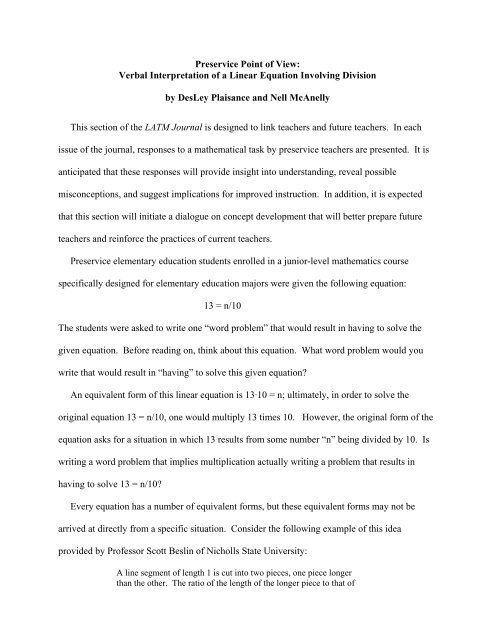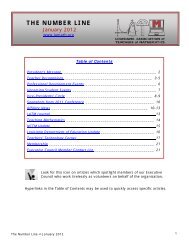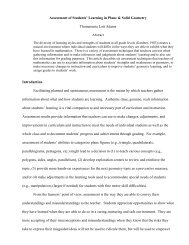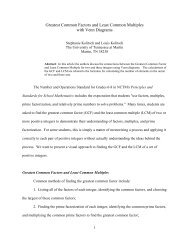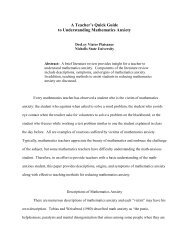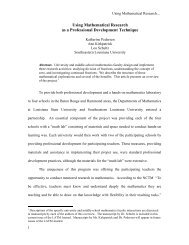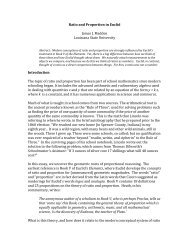Verbal Interpretation of a Linear Equation Involving Division
Verbal Interpretation of a Linear Equation Involving Division
Verbal Interpretation of a Linear Equation Involving Division
Create successful ePaper yourself
Turn your PDF publications into a flip-book with our unique Google optimized e-Paper software.
<strong>of</strong> the shorter piece is the same as the ratio <strong>of</strong> the length <strong>of</strong> the entiresegment to that <strong>of</strong> the longer piece. What is the length <strong>of</strong> the longerpiece?If the longer piece is represented by “ x ” and the shorter piece represented by “1−x ,” thenthe equation applicable to the situation would be as follows:x 1=1−x xAn equivalent form <strong>of</strong> this equation is x2 + x− 1= 0. However, it is highly unlikelythat anyone would write this second form in response to the line segment problem, and in factthis second form does not aptly represent the concept <strong>of</strong> ratio referred to in the problem.Therefore, is writing a word problem that would most likely result in the equation 13·10 = n beappropriate for the problem posed in which one is asked to write a word problem resulting inhaving to solve the equation 13 = n/10? This idea is what may make the posed questioninteresting to some. Are there any non-contrived situations that would result in one having tosolve the equation in its given form <strong>of</strong> 13 = n/10?When examining the work <strong>of</strong> the preservice elementary education students, an overwhelmingmajority (31 <strong>of</strong> 38 responses) <strong>of</strong> the students wrote word problems that “could” be solved byutilizing the given equation, but probably would be solved by directly multiplying 13 times 10.All <strong>of</strong> these problems asked in some form to “find the total” needed for 13 groups <strong>of</strong> 10 or 10groups <strong>of</strong> 13. Some responses <strong>of</strong> this type are as follows:1) Tania had to split a group <strong>of</strong> students into 10 groups. There were 13 students in eachgroup. How many were students were there?2) Jane baked cookies for a party she was attending. After baking all <strong>of</strong> the cookies sheput 10 cookies on each tray. When she was through, she had 13 trays <strong>of</strong> cookies. Howmany cookies did she bake all together?3) Betsy is setting up for a banquet. She found that when she set up the room, sheneeded 13 tables. Each table had 10 chairs around the table. If each person gets onechair, how many people are attending the banquet?Four <strong>of</strong> the 38 responses were incorrect in that the word problems did not result
in one having to solve the given equation directly or indirectly. All used the numbers “13” and“10” but did not result in having to eventually multiply those two numbers. All responsesinvolve division, but not dividing the unknown quantity by 10 in order to get the quotient<strong>of</strong> 13. These responses are as follows:1) Jordan has 13 pieces <strong>of</strong> apple. She wants to put the apple pieces into 10 groups.How many apple pieces are there in each group?2) You have a class with “n” amount <strong>of</strong> students. If you divide this amount by 10, howmany groups <strong>of</strong> students do you have if the total <strong>of</strong> students in class is 13. Explain. Doyou have an exact amount <strong>of</strong> groups? Explain.3) Farmer Paul has 130 cows and needs them in rows <strong>of</strong> 10. How many columns will thecows be in?4) What would 10 need to be divided by to get the quotient <strong>of</strong> 13?Two <strong>of</strong> the 38 students providing responses used the variable “n” within the wordproblem. These responses provided problems that seem to result in solving the equationn/10 = 13 directly. The exact equation given in the assignment is 13 = n/10. Thesymmetric property <strong>of</strong> equality (If a=b, then b=a.) allows one to rewrite an equation in thismanner. Therefore, would n/10=13 be considered a “different form” <strong>of</strong> 13 = n/10? In bothequations one is looking for some quantity that has to be divided by 10 to arrive at the quotient<strong>of</strong> 13. It is possible that some may consider n/10 = 13 and 13 = n/10 as two different forms.The student responses are as follows:1) There are n children that attended vacation bible school this summer. We knowthat there were 10 children in each group and 13 groups. How many children attendedvacation bible school?2) Ms. Kelly had “n” pieces <strong>of</strong> candy to hand out among 10 students. Each studentreceived 13 pieces. How many pieces did Ms. Kelly start with?The final student wrote a word problem that again resulted in having tomultiply 13 times 10. However, it appears that the student may have been thinking about the
equation as a proportion in that he represented the “13” as ratio <strong>of</strong> “miles per gallon.” Theproblem is as follows:My car gets 13 miles per gallon <strong>of</strong> gasoline. If I used 10 gallons on a road tripyesterday, how many miles did I drive?One <strong>of</strong> the goals <strong>of</strong> this column is to “initiate a dialogue on concept development.” Therewas definitely a “dialogue” as the column was being written. Think about the problem posedwith 13 = n/10. Have your students think about this problem. We believe that there will be quitean engaging dialogue.Dr. DesLey Plaisance is currently an Assistant Pr<strong>of</strong>essor in the Department <strong>of</strong> Mathematics andComputer Science at Nicholls State University and serves as Coordinator <strong>of</strong> Graduate Studies inMathematics. She teaches undergraduate courses in mathematics for education majors andgraduate courses in mathematics curriculum/research. Plaisance’s primary research focus ismathematics anxiety <strong>of</strong> preservice elementary teachers. She is the Community Relations Officer<strong>of</strong> the LATM Executive Council.Mrs. Nell McAnelly is Co-Director <strong>of</strong> the Gordon A. Cain Center for Scientific, Mathematical,Engineering, and Technology Literacy and is a mathematics instructor at LSU-BR. Her mostrecent teaching focuses on mathematics content courses for elementary education majors.McAnelly oversees numerous pr<strong>of</strong>essional development projects for mathematics and scienceteachers from kindergarten through twelfth grade and is the Executive Director <strong>of</strong> the QualityScience and Math Grant Program. She presently serves on the LATM Executive Council asTreasurer.


